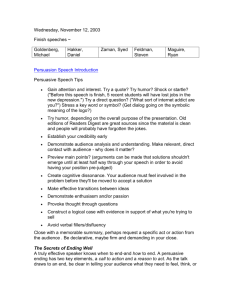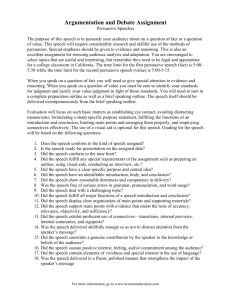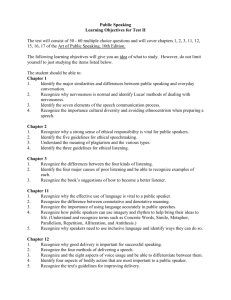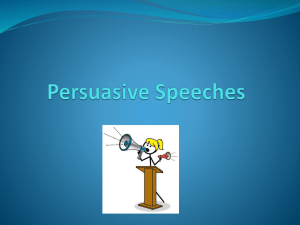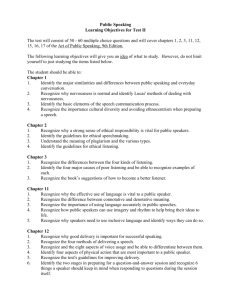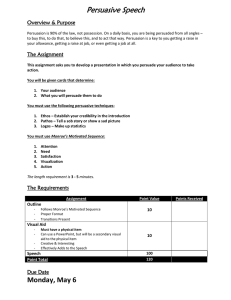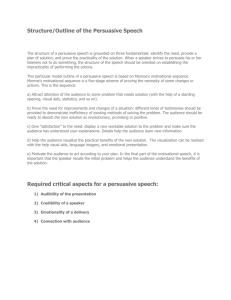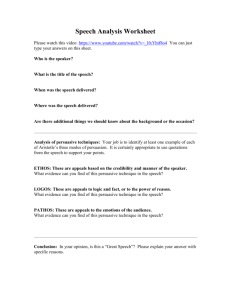Monroe's Motivated Sequence
advertisement
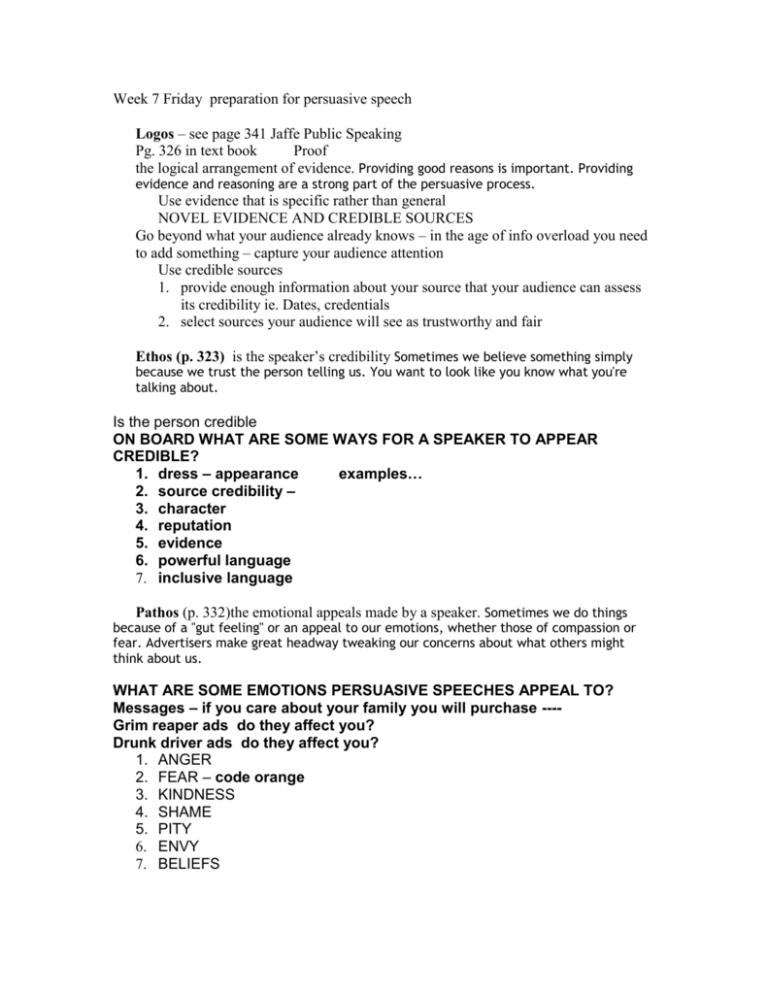
Week 7 Friday preparation for persuasive speech Logos – see page 341 Jaffe Public Speaking Pg. 326 in text book Proof the logical arrangement of evidence. Providing good reasons is important. Providing evidence and reasoning are a strong part of the persuasive process. Use evidence that is specific rather than general NOVEL EVIDENCE AND CREDIBLE SOURCES Go beyond what your audience already knows – in the age of info overload you need to add something – capture your audience attention Use credible sources 1. provide enough information about your source that your audience can assess its credibility ie. Dates, credentials 2. select sources your audience will see as trustworthy and fair Ethos (p. 323) is the speaker’s credibility Sometimes we believe something simply because we trust the person telling us. You want to look like you know what you're talking about. Is the person credible ON BOARD WHAT ARE SOME WAYS FOR A SPEAKER TO APPEAR CREDIBLE? 1. dress – appearance examples… 2. source credibility – 3. character 4. reputation 5. evidence 6. powerful language 7. inclusive language Pathos (p. 332)the emotional appeals made by a speaker. Sometimes we do things because of a "gut feeling" or an appeal to our emotions, whether those of compassion or fear. Advertisers make great headway tweaking our concerns about what others might think about us. WHAT ARE SOME EMOTIONS PERSUASIVE SPEECHES APPEAL TO? Messages – if you care about your family you will purchase ---Grim reaper ads do they affect you? Drunk driver ads do they affect you? 1. ANGER 2. FEAR – code orange 3. KINDNESS 4. SHAME 5. PITY 6. ENVY 7. BELIEFS Monroe’s Motivated Sequence page 197 in text book see http://webct.albany.edu:8900/SCRIPT/acom203_2106_fall03/scripts/serve_home Overheads Sound Reasoning – one of the most important aspects of entering the public dialogue is sound reasoning. Sound reasoning ensures that your issues and perspectives are developed and discussed fairly and ethically. It ensures that your claims make sense to you and to your audience. Monroe’s Motivated Sequence I. ATTENTION STEP (introduction) II. NEED STEP (the problem) [BODY] III. SATISFACTION STEP (the solution) [BODY] IV. VISUALIZATION STEP [BODY] V. ACTION STEP (what do you want the audience to do) [CONCLUSION] I. ATTENTION STEP (introduction) 1. Attention Getter - Attention-getters grab the audience, arousing curiosity about what the speaker is going to say. To help avoid the effects of psychological reactance, the preview statement can be omitted. 2. Orient Audience Toward Topic 3. Credibility Statement 2. NEED STEP (the problem) [BODY] You must establish a clear, urgent, and unfulfilled need in the mind of the audience. This is a critical step in the sequence. No solutions should be proposed during this stage. 1. Statement of Need - Offer a clear statement of what the problem entails. 2. Illustration of Need - Present one or more stories to give listeners an initial idea of the problem's seriousness and scope. You have two options here. First, you may want to provide your audience with an extended narrative. Second, you may want to provide the listeners with several shorter examples, which represent the same underlying argument that you are making in this portion of the performance. 3. Ramification - Clarify your statement of need and justify the concern using statistical support and/or testimony, etc. Speakers can utilize the qualitative or quantitative approach to demonstrating harm. 4. Pointing - Indicate why this particular audience should be concerned. Example: "We all as college students”, "We as Massachusetts residents" etc. 3. SATISFACTION STEP (the solution) [BODY] Present the solution to the needs or problems described in step two. During this stage, speakers must also identify and eliminate possible objections to the solution. 1. Statement of Solution - Statement of the attitude, belief, or action that you wish the audience to adopt (this should only be one sentence). This statement should resolve the problem you mention in the Statement of Need step. 2. Explanation - Explain your solution to the audience 3. Theoretical Demonstration - Demonstrate to your audience how your solution logically meets the problem pointed out in the need step 4. Workability -If appropriate, present examples showing that this solution has worked effectively in the past or that this solution has been advocated by experts in the field. 5. Meeting Objections -Answer possible objectives that might be raised 4. VISUALIZATION STEP [BODY] IV. VISUALIZATION STEP (what the world will look like with or without your solution) Intensify audience members' desire for the solution by getting them to visualize what their lives will be like once they've adopted it. Use vivid images and verbal illustrations to support the benefits of the proposed solution. 1. Positive Method- Describe favorable conditions that will occur if the audience accepts your solution. 2. Negative Method- Describe the adverse conditions that will prevail or intensify in the future if the audience does not adopt the belief you advocate or carry out the solution that you propose. 3. Contrast Method- Forecast the negative possibilities and then the positive attributes that can be expected if the audience members implement your solution. 5. ACTION STEP (what do you want the audience to do) [CONCLUSION] video MUSIC MAN AS ILLUSTRATION OF PERSUASIVE SPEECH In the final step, the speaker must turn the audience's agreement and commitment into positive action. Tell audience members what they need. to do to obtain the described solution and its benefits. Urge the audience to take the specific action outlined in the satisfaction step. Language is much more than what we hear – these two clips both only a couple of minutes will show what is being said without knowing the actual words – does the body language suit the rhetoric? Speaking to Convince The purpose of convincing speech is to advance a proposition of policy or evaluation or to propose a new solution to a problem. You should ask the audience to change attitudes or beliefs on an issue of importance to you. Video and handout sheets for Report 2
